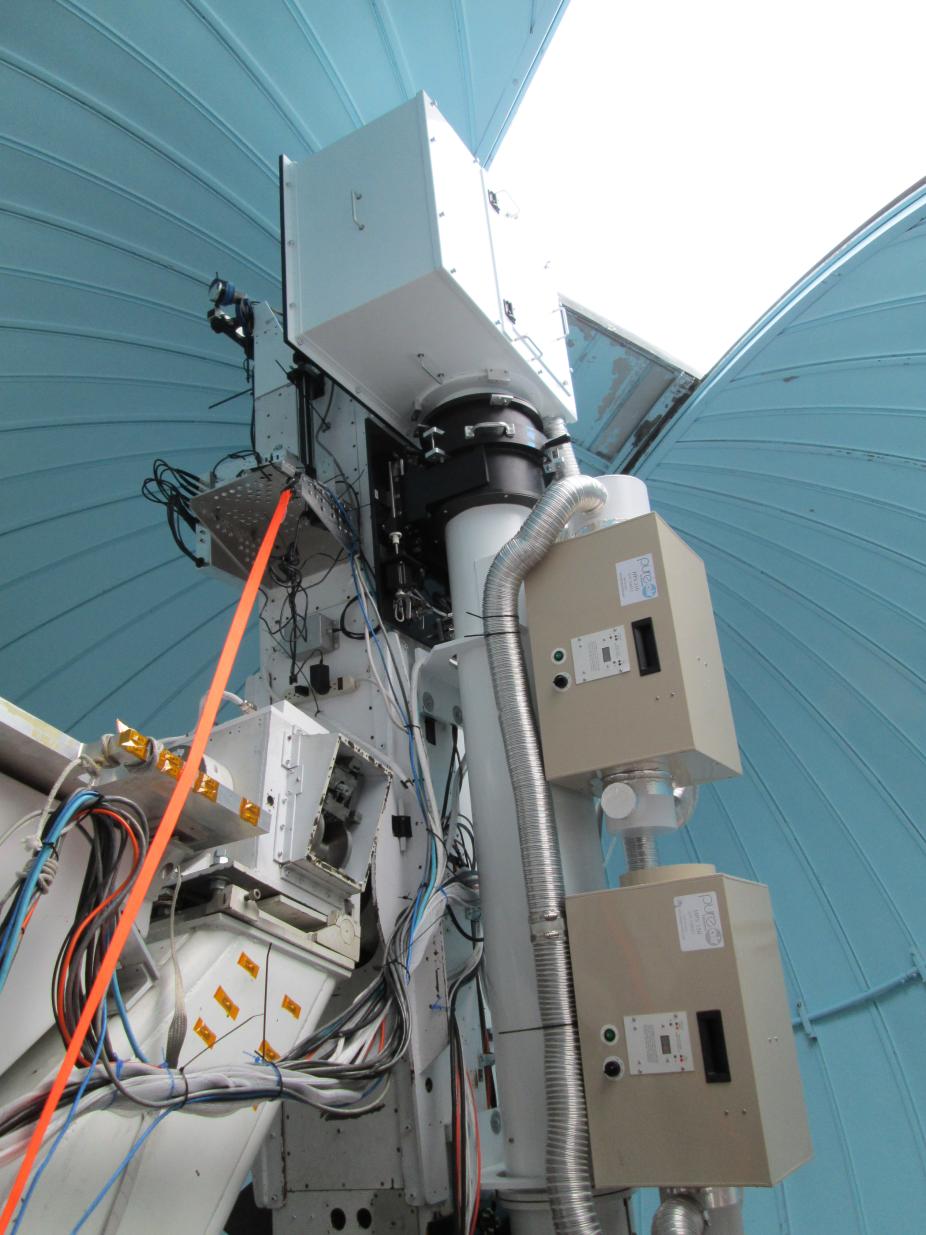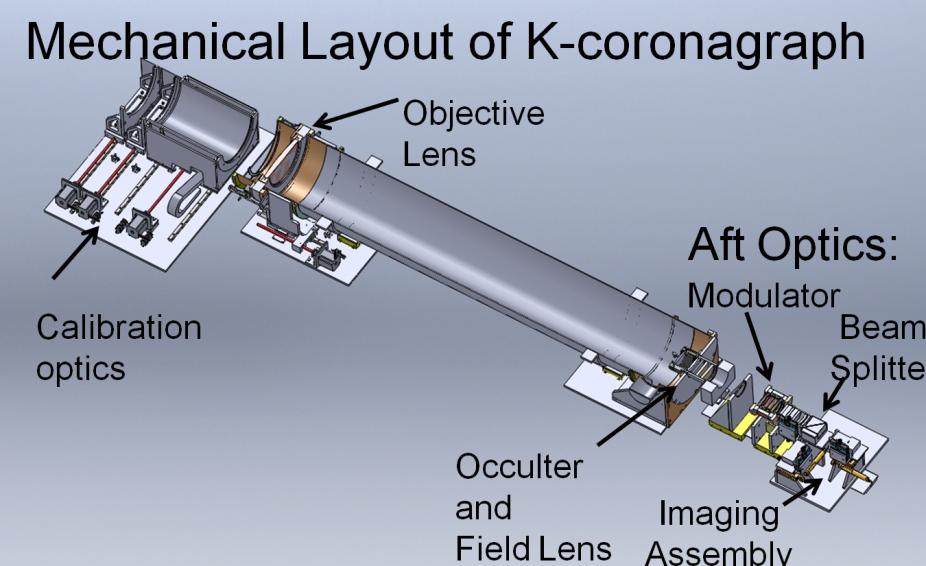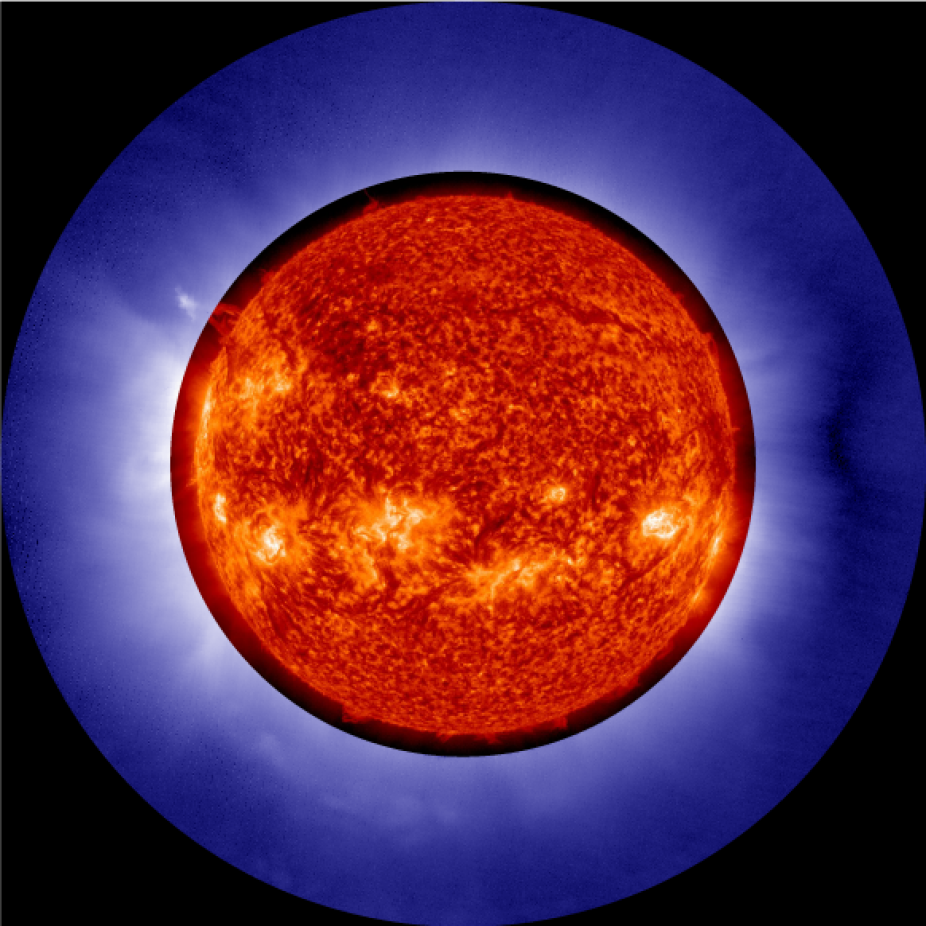COSMO K-Coronagraph

K-Cor on the MLSO spar
Download: K-cor instrument, calibration and data products guide
The COronal Solar Magnetism Observatory (COSMO) K-coronagraph (K-Cor) is one of three proposed instruments in the COSMO facility suite. It is specifically designed to study the formation and dynamics of coronal mass ejections and the evolution of the density structure of the low corona. The K-Cor records the polarization brightness (pB) formed by Thomson scattering of photospheric light by coronal free electrons. The National Center for Atmospheric Research (NCAR), via the National Science Foundation (NSF), provided full funding for the COSMO K-Cor, which was deployed to the Mauna Loa Solar Observatory (MLSO) in Hawaii in September 2013, replacing the aging MLSO Mk4 K-coronameter.
K-Cor Basic Description
The COSMO K-Coronagraph design was driven by the science goals of understanding the formation of CMEs and the structure and evolution of the low corona. Basic features of the K-Cor design include:

K-Cor schematic
- Internally occulted refractive coronagraph
- Field-of-view (FOV): 1.05 to 3 solar radii
- Aperture: 20 cm uncoated singlet objective lens
- Focal Length: 2 m (f/10)
- Pass band: ~720 to 750 nm
- Out-of-band rejection
- Lyot Stop
- 4-state polarization modulation
- Dual beam polarization ; 2 cameras to simultaneously record polarization states
- 5.5 arcsec pixels
- Nominal cadence: 15 seconds (can run faster in campaign mode
Science Goals and Instrument Requirements
The four primary science goals that determined the design of the COSMO K-Cor are:
- Understand the formation of CMEs and their relation to other forms of solar activity.
- Identify Earth-directed CMEs (halos) in real time.
- Measure the radial brightness in coronal holes from 1.05 solar radii to at least 1.5 solar radii.
- Determine the density distribution of the corona over solar cycle time scales.

K-Cor/AIA Composite
To meet the first science requirement, K-Cor has a FOV down to 1.05 solar radii and a time cadence of 15 seconds. FOV goals were derived from a variety of existing observations. Most CMEs observed with the MLSO Mk3 and Mk4 K-coronameters appeared to form below the apparent height of the occulter (1.15 solar radii) and had their largest acceleration occur at or below 3 solar radii. Instruments such as TRACE and the YOHKOH SXT had high time cadence observations of CMEs (13 to 40 sec) that provided insights into the rapid formation and evolution of CMEs and their relation to other forms of activity but these instruments were limited; TRACE by its 8.5 arcmin field-of-view (FOV) and Yohkoh SXT by its insensitivity to plasmas with temperatures below 2 million degrees. The COSMO K-Cor will provide the first routine white light observations into the first coronal scale height with a time cadence optimized to study the dynamics of CME formation.
The next two science requirements, observing halo CMEs and density profiles in coronal holes, require polarization brightness (pB) noise levels of a few x 10^-10 B/Bsun (where Bsun is the brightness of the solar disk). Identifying halo CMEs in real time provides valuable information on CME properties for space weather forecasts. Measuring the radial brightness in coronal holes, and their finer structures such as polar plumes, yields density information in open field regions that can be used to constrain models of energy deposition into the solar atmosphere that drives the solar wind.
The final science goal requires a robust instrument, with reliable calibration hardware that can be operated and maintained over decades time scales.
Reliable and accurate calibrated data greatly enhances the ability to meet all mission science goals.
A summary of K-Cor instrument requirements is given in Table 1.
Table 1 - K-Cor Instrument Requirements
| QUANTITY | UNITS | REQUIREMENT | COMPARISON TO MK |
| Field-of-view (FOV) | Solar Diameter | 3 | 2.8 |
| FOV lower limit | Arcsec | 50 | 120 |
| Spatial Sampling | Arcsec | 6 | 5 to 23 (increased with height) |
For more information about K-Cor, please visit: A New Coronagraph for Mauna Loa.